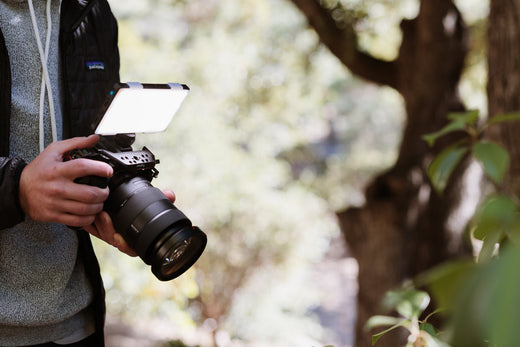Which is Best for Photographers and Videographers?
When it comes to lighting for photography and videography, choosing between bicolor and RGB LEDs can make a difference in the look and feel of your content. Both types of lighting offer advantages, and the best choice depends on your needs. In this blog, we’ll break down the benefits of bicolor LED and RGB LED lighting, and explain when to use each to help you decide which is right for your work.

What is Bicolor LED Lighting?
So let’s start off with what Bicolor LED lights allow you to do - they adjust between two different color temperatures: typically warm light (around 3200K) and cool light (around 5600K). This makes them highly versatile for situations where you need to balance between different lighting environments.
Benefits of Bicolor LEDs
-
Precise Control Over Color Temperature: Bicolor LEDs give you control over the warmth or coolness of your light. You can seamlessly transition between warm and cool lighting to match the existing ambient light or create a specific mood.
-
Natural, Neutral Lighting: Bicolor LEDs are perfect for creating natural-looking light, making them ideal for portrait photography, interviews, and product shots where accurate skin tones or product colors are essential.
-
Easy to Use: Bicolor lights are straightforward, making them an excellent choice for photographers and videographers who need to quickly adjust their lighting.
When to Use Bicolor LEDs
Bicolor LEDs are best for scenarios where color accuracy and natural lighting are crucial:
-
Portrait Photography: When you need to make skin tones look realistic and flattering, bicolor lighting offers the flexibility to match ambient light or create warm or cool effects based on the subject’s skin tone.
-
Product Photography: Bicolor LEDs allow you to create consistent lighting, ensuring the product’s true color is captured accurately.
-
Interviews and Corporate Videos: In professional settings where you want to maintain a clean and neutral look, bicolor lighting is the go-to option.

What is RGB LED Lighting?
Now, RGB LEDs allow you to create a wide range of colors by combining red, green, and blue lights. These lights can produce virtually any color on the spectrum, making them a favorite for photographers and videographers looking for creative and dynamic lighting solutions.
Benefits of RGB LEDs
-
Unlimited Color Options: RGB lights give you the ability to mix colors and create any shade you can imagine, offering endless possibilities for creative lighting setups.
-
Dramatic and Creative Effects: Whether you’re shooting a music video, creating a colorful backdrop, or adding a dramatic aspect to your photos, RGB LEDs provide the flexibility to experiment with various colors and moods.
-
Customizable Scenes: Many RGB lights allow for custom lighting effects, such as color transitions, pulses, and strobe lighting, making them great for videos and creative shoots.
When to Use RGB LEDs
RGB LEDs are best for situations where creativity and dynamic lighting are the primary focus:
- Creative and Artistic Photography: If your goal is to create unique, eye-catching images with bold colors or interesting lighting effects, RGB lighting gives you complete creative freedom.
- Music Videos and Cinematic Shoots: RGB LEDs are ideal for adding a dramatic mood to videos, allowing for colorful, vibrant scenes that enhance the storytelling.
- Event Photography: For parties, concerts, or live events, RGB lighting can add atmosphere and excitement, helping to create more memorable images.
Bicolor vs. RGB: Which is Best for You?
The choice between bicolor and RGB LEDs ultimately depends on the type of photography or videography you’re doing. Here’s a breakdown of when each type of lighting is a good option:
Choose Bicolor LED If:
-
You need a reliable, easy-to-use light that produces natural, flattering results.
-
You frequently shoot portraits, products, interviews, or corporate videos where accurate color representation and skin tones are critical.
-
You need to quickly adjust your lighting to match natural daylight or indoor environments.
Choose RGB LED If:
- You want to get creative with lighting and need full control over color for artistic or dynamic projects.
- You’re working on music videos, creative photography, or cinematic shoots where mood and atmosphere are essential.
- You enjoy experimenting with lighting effects and need the flexibility to produce unique, colorful lighting setups.
Both bicolor and RGB LEDs have their place in photography and videography. If you’re working on professional portraits, product shots, or corporate videos where natural lighting and accurate color representation are crucial, bicolor LEDs are likely the best option for you. On the other hand, if your projects involve creative, dynamic lighting effects, RGB LEDs will give you the flexibility and control needed to produce vibrant and artistic results.
Whichever you choose, here are a few of our favorite bicolor and RGB LED lights that can meet your creative and professional needs.



STUDIO PANEL LIGHTING KIT - SHOP NOW





















